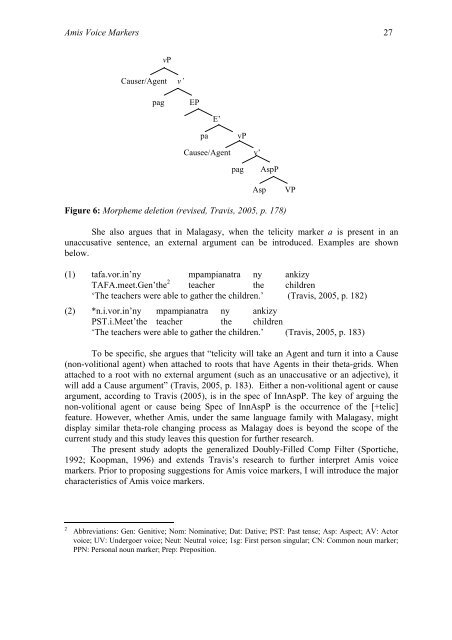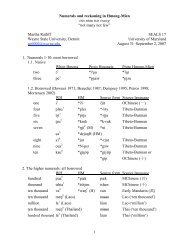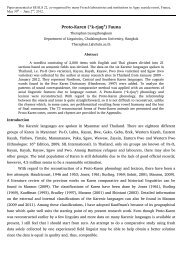proto-southwestern-tai revised: a new reconstruction - seals 22
proto-southwestern-tai revised: a new reconstruction - seals 22
proto-southwestern-tai revised: a new reconstruction - seals 22
Create successful ePaper yourself
Turn your PDF publications into a flip-book with our unique Google optimized e-Paper software.
Amis Voice Markers 27<br />
vP<br />
Causer/Agent v’<br />
pag EP<br />
E’<br />
pa vP<br />
Causee/Agent v’<br />
pag AspP<br />
Asp VP<br />
Figure 6: Morpheme deletion (<strong>revised</strong>, Travis, 2005, p. 178)<br />
She also argues that in Malagasy, when the telicity marker a is present in an<br />
unaccusative sentence, an external argument can be introduced. Examples are shown<br />
below.<br />
(1) tafa.vor.in’ny mpampianatra ny ankizy<br />
TAFA.meet.Gen’the 2 teacher the children<br />
‘The teachers were able to gather the children.’ (Travis, 2005, p. 182)<br />
(2) *n.i.vor.in’ny mpampianatra ny ankizy<br />
PST.i.Meet’the teacher the children<br />
‘The teachers were able to gather the children.’ (Travis, 2005, p. 183)<br />
To be specific, she argues that “telicity will take an Agent and turn it into a Cause<br />
(non-volitional agent) when attached to roots that have Agents in their theta-grids. When<br />
attached to a root with no external argument (such as an unaccusative or an adjective), it<br />
will add a Cause argument” (Travis, 2005, p. 183). Either a non-volitional agent or cause<br />
argument, according to Travis (2005), is in the spec of InnAspP. The key of arguing the<br />
non-volitional agent or cause being Spec of InnAspP is the occurrence of the [+telic]<br />
feature. However, whether Amis, under the same language family with Malagasy, might<br />
display similar theta-role changing process as Malagay does is beyond the scope of the<br />
current study and this study leaves this question for further research.<br />
The present study adopts the generalized Doubly-Filled Comp Filter (Sportiche,<br />
1992; Koopman, 1996) and extends Travis’s research to further interpret Amis voice<br />
markers. Prior to proposing suggestions for Amis voice markers, I will introduce the major<br />
characteristics of Amis voice markers.<br />
2 Abbreviations: Gen: Genitive; Nom: Nominative; Dat: Dative; PST: Past tense; Asp: Aspect; AV: Actor<br />
voice; UV: Undergoer voice; Neut: Neutral voice; 1sg: First person singular; CN: Common noun marker;<br />
PPN: Personal noun marker; Prep: Preposition.





